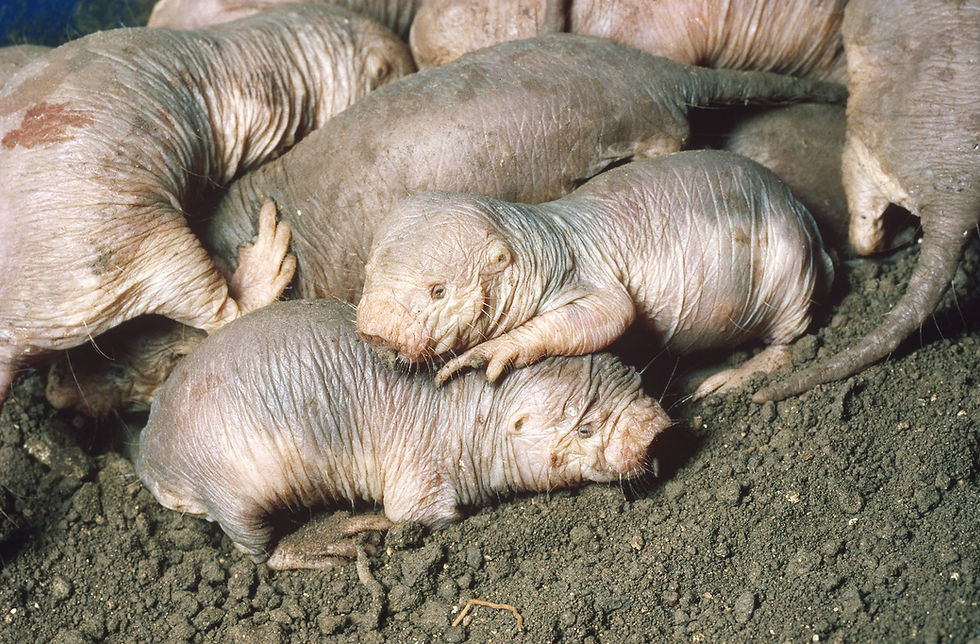Naked mole rat, the key to immortality ?
- Simon De Myttenaere

- May 9, 2023
- 3 min read
The naked mole rat, rodent of the Bathyergidae family, has a multitude of surprising and interesting properties for the health industry: fighting cancer, slowing down aging... So many problems that are the subject of research and that the mole rat has already solved!
The naked mole rat takes a bite out of life by digging tunnels
Mole rats are rodents that live in East Africa. Among this family, one species stands out by its particular aspect: it is the naked mole-rat.
This almost blind subterranean mammal lives in a network of tunnels that measure up to 5 km long. The naked mole-rat digs these tunnels with its teeth, a function so important to it that a quarter of its musculature is dedicated to its jaw! Moreover, it is able to move backwards as fast as forwards!
Its underground lifestyle is explained by its diet. It is indeed herbivorous and particularly likes arid environments. In these dry areas, plants store most of their resources (water and nutrients) in their bulbs and roots. It is these parts that are targeted by naked mole rats. That way, they don't even need to drink. However, they show remarkable resource management: they leave part of the roots intact after they have eaten so that the plant can continue to grow. This ensures them a sustainable food source.
The concentration of oxygen in the tunnels in which it lives being very low, it has developed a unique ability to survive without oxygen: it can go 18 minutes without oxygen without feeling any change!

Naked mole-rat digging a tunnel with its teeth.
Credits : Justin O’Riain
The naked mole-rat, an animal living in very organized society
The naked mole rat and the Damara mole rat are the only 2 species of eusocial mammals: they organize themselves in colonies led by a fertile individual, like bees and ants. They live in colonies of 80 individuals on average, but their number can go up to 300 individuals!
They are organized around a queen and 3 reproductive males while the rest of the colony is sterile. There is a caste system, with soldiers (the largest) and workers.
A study published on January 29 2021 in Science showed that each mole rat colony has its own dialect. This allows them to quickly spot intruders in the colony and to chase them away.
On the other hand, when a colony is expanding, it does not hesitate to kidnap babies from neighboring colonies to make them slaves, according to a study published in the Journal Of Zoology.

A naked mole-rat colony
Credits : Gregory G Dimijian / Getty Images/Science Source
Is the naked mole-rat holding the key to the fight cancer ?
This small rodent is very resourceful and gives ideas to many researchers around the world.
Indeed, it has an extraordinary longevity for a rodent: it can live up to 32 years, while mice do not live more than 4 years. This is due to its much slower metabolism which allows it to save its energy. Even stronger, it does not show metabolic signs of aging. Older individuals are just as physically strong and able to reproduce as younger ones! This is the surprising result discovered by Rochelle Buffenstein who has been studying them for more than 30 years in the journal eLife.
Not only does old age not affect them, but they do not develop cancer either. They have a special gene that prevents the proliferation of cells and therefore the development of tumors. On the other hand, they have molecules of hyaluronic acid 5 times bigger than those of humans in their cells according to a study published in Nature. This molecule prevents the agglutination of cells, thus fighting again against the proliferation of cancer cells.

Cell division of a cell
The mole rat is therefore a message of hope for the health sector. Like the jellyfish, this rodent defies the laws of time and aging, which suggests a whole range of biotechnology possibilities for fighting cancer and other degenerative diseases. The French team of skin biology of the Cochin Institute is conducting research on the theme of skin aging: in tomorrow's world, thanks to them, no more wrinkles or skin cancers!
Credits cover photo : J. Adam Fenster / University of Rochester




Comments